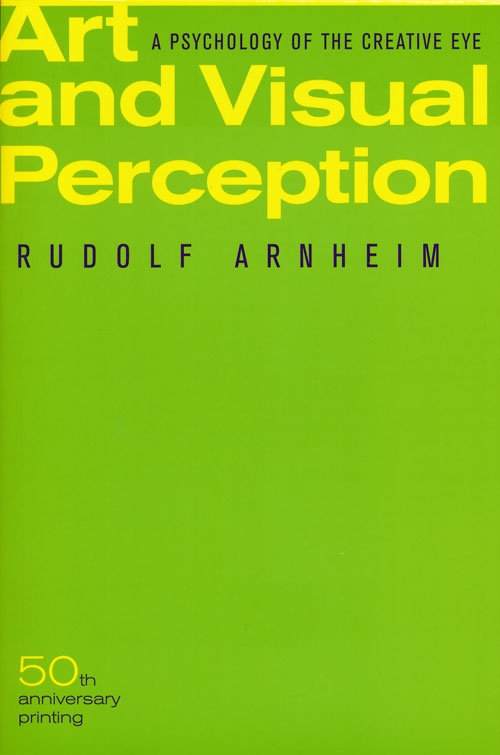Rudolf Arnheim: Art and Visual Perception (1954–) [EN, RU, PL, RO, ES, BR-PT]
Filed under book | Tags: · architecture, art theory, colour, kinesthesia, light, movement, music, painting, perception, perspective, physiology, psychology, sculpture

“Since its publication in 1954, this work has established itself as a classic. It casts the visual process in psychological terms and describes the creative way one’s eye organizes visual material according to specific psychological premises. In 1974 this book was revised and expanded, and since then it has continued to burnish Rudolf Arnheim’s reputation as a groundbreaking theoretician in the fields of art and psychology.”
Publisher University of California Press, 1954
Expanded and revised edition, 1974
ISBN 0520243838
508 pages
Interview with the author (Uta Grundmann, Cabinet, 2001)
Publisher (EN)
Art and Visual Perception (English, 1954/1974, 26 MB)
Iskusstvo i vizualnoe vospriyatie (Russian, trans. V.N. Samokhin, 1974/2000, DJVU, no OCR)
Sztuka i percepcja wzrokowa (Polish, trans. Jolanta Mach, 1978, 24 MB, no OCR, via nuitienne)
Arta si perceptia vizuala (Romanian, trans. Florin Ionescu, 1979, 35 MB, no OCR, via)
Arte y percepción visual (Spanish, trans. María Luisa Balseiro, 1979/1997, 43 MB)
Arte e percepção visual (Brazilian Portuguese, trans. Ivonne Terezinha de Faria, 1980/2005)
Brian Massumi: Semblance and Event: Activist Philosophy and the Occurrent Arts (2011)
Filed under book | Tags: · abstract art, aesthetics, art, event, interactive art, kinesthesia, movement, perception, performance art, philosophy, politics, proprioception, semblance, time, vision

Events are always passing; to experience an event is to experience the passing. But how do we perceive an experience that encompasses the just-was and the is-about-to-be as much as what is actually present? In Semblance and Event, Brian Massumi, drawing on the work of William James, Alfred North Whitehead, Gilles Deleuze, and others, develops the concept of “semblance” as a way to approach this question.
It is, he argues, a question of abstraction, not as the opposite of the concrete but as a dimension of it: “lived abstraction.” A semblance is a lived abstraction. Massumi uses the category of the semblance to investigate practices of art that are relational and event-oriented–variously known as interactive art, ephemeral art, performance art, art intervention–which he refers to collectively as the “occurrent arts.” Massumi argues that traditional art practices, including perspective painting, conventionally considered to be object-oriented freeze frames, also organize events of perception, and must be considered occurrent arts in their own way. Each art practice invents its own kinds of relational events of lived abstraction, to produce a signature species of semblance.
The artwork’s relational engagement, Massumi continues, gives it a political valence just as necessary and immediate as the aesthetic dimension. Massumi investigates occurrent art practices in order to examine, on the broadest level, how the aesthetic and the political are always intertwined in any creative activity.
Publisher MIT Press, 2011
Technologies of Lived Abstraction series
ISBN 0262134918, 9780262134910
220 pages
PDF (updated on 2012-7-24)
Comment (0)
